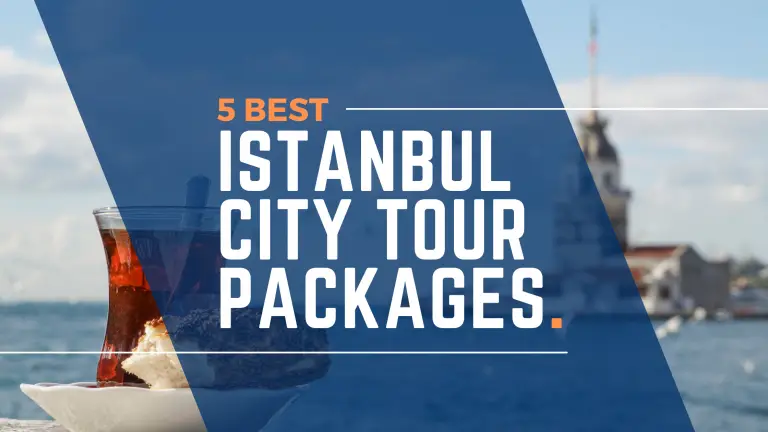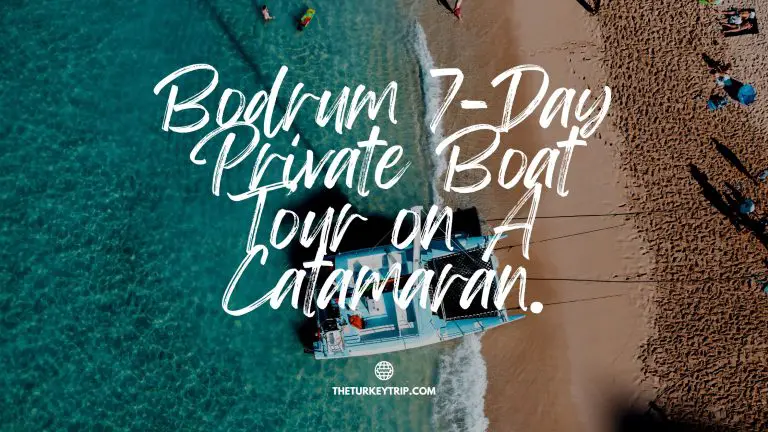What To See In Turkey In 10 Days: Historical And Cultural Places Worth Visiting
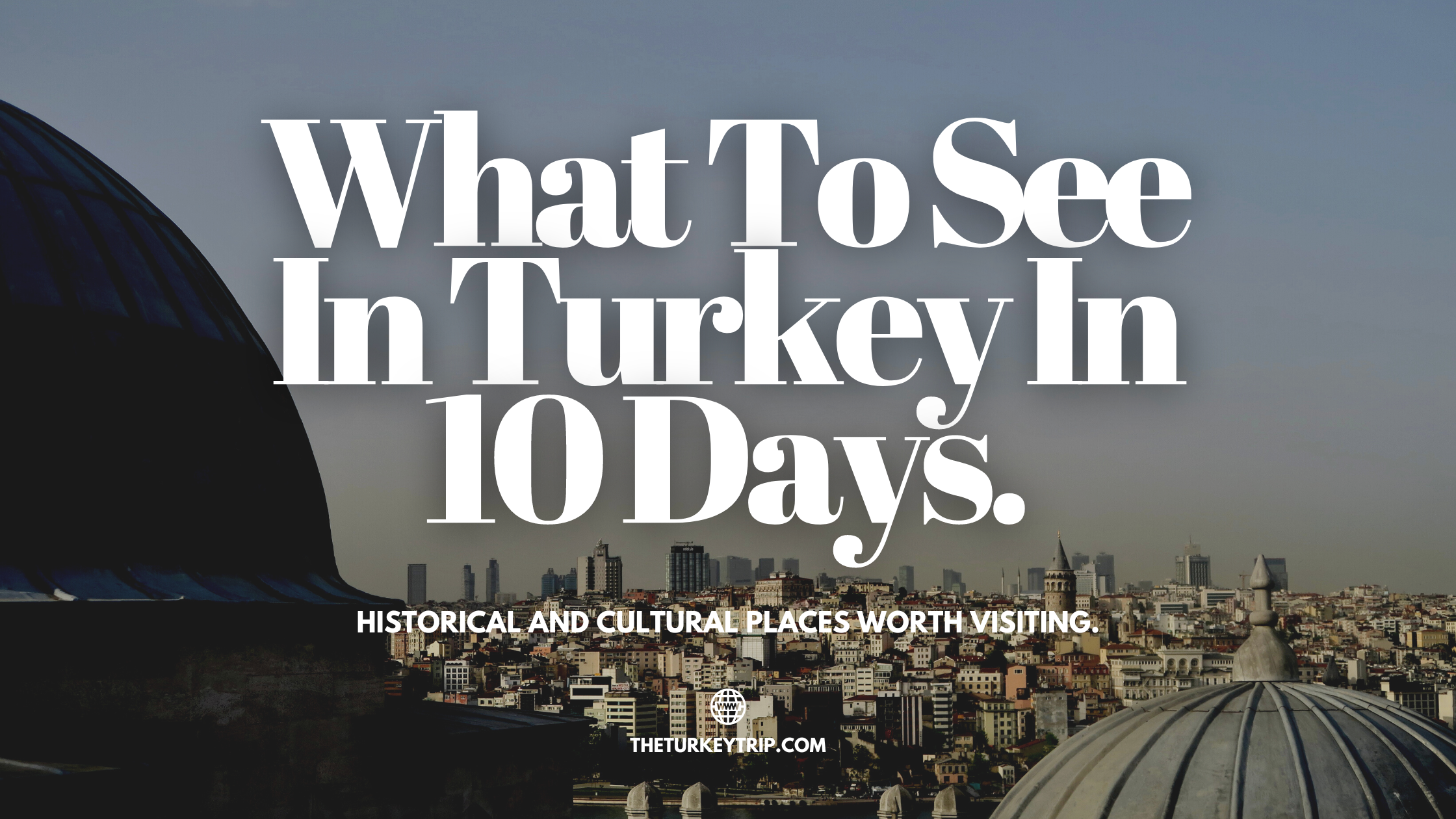
10 days is a good amount of time to explore Turkey. To get the best vacation experience, of course, you should know what to see in Turkey in 10 days. Visiting cultural and historical places, and witnessing natural beauty should be considered to be included in your Turkey vacation itinerary.
Turkey is a favorite tourist destination. In recent years, Turkey has been considered one of the top 10 popular tourist destinations in the world.
Turkey is famous for being the home of many historical, cultural, and natural attractions. This is the reason why people always want to come to Turkey to explore these places.
What we recommend, 7 to 10 days is the best time for a vacation in Turkey.
You can visit Istanbul, Bursa, Kusadasi, Pamukkale, and Cappadocia in 7 days. Of course, you will have the opportunity to visit more tourist attractions within 10 days in Turkey.
10 days is the recommended time to explore more, in addition to the usual tourist attractions.
You should also note that Turkey is a big country. The distances between cities can be far. You have to pay attention to the distances when compiling a Turkey vacation itinerary.
If you want an unhurried vacation and can explore unusual places, then renting a car in Turkey can be a good option. But if you want a vacation that makes the most of your time, then you can consider using domestic flights. These flights are useful for saving time, so you can visit more tourist attractions in Turkey.
Deciding to vacation in Turkey for 10 days is the right decision.
Here you can find out what you can see in Turkey in 10 days. And we will also show you how a 10-day Turkey vacation itinerary can be an enjoyable experience.
Do you want a 10-day Turkey vacation? Some of our tour package recommendations below might be useful for you:

One Of The Best: 10-Day Turkey LUXURY Private Tour Package from Istanbul 2023
Are you looking for a tour experience different from the usual one? Then you can consider experiencing a luxury tour in Turkey. One of the recommendations is the 10-Day Turkey private luxury tour packages from Istanbul, visiting other popular cities in Turkey such as Kusadasi, Pamukkale, and Cappadocia. With luxurious services, you will get top-inclusive…
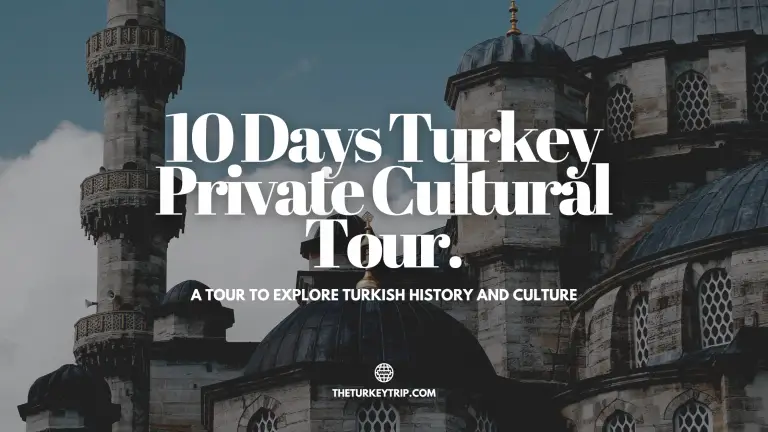
A recommendation: 10 Days Turkey Private Cultural Tour Package Start From Istanbul (Great For A Family Trip In 2023)
10 days is good enough for having a vacation in Turkey. It is a very sufficient time to explore Turkey. In the duration of a visit of 9 nights 10 days, you can already visit many popular tourist attractions in Turkey. Of the many types of tours that you can take, one that you can…
What to see in Turkey in 10 days.
There are so many route options (destinations) to explore when you are on vacation in Turkey.
These destinations can be determined based on the season when you are on vacation, the purpose of your vacation, or other reasons.
Among the many reasons, we see that one of the reasons why many people vacation in Turkey, especially when they decide to take a 10-day vacation, is because they want to witness the history and culture of Turkey.
In this article, we will focus on the historical and cultural attractions that you can visit when you have a 10-day vacation in Turkey.
The destinations (cities) in Turkey that you can explore its history and culture in 10 days are:
- Istanbul.
- Gallipoli.
- Çanakkale.
- Bergama.
- Kusadasi.
- Pamukkale.
- Cappadocia.
Below you can see which historical and cultural attractions you can visit in those places.
Istanbul.
1. Hagia Sophia Mosque.
 A.Savin, FAL, via Wikimedia Commons
A.Savin, FAL, via Wikimedia Commons
Hagia Sophia is an important historical and cultural site in Istanbul.
The Great Mosque of Hagia Sophia was once a Greek Orthodox church that dates back to 360 AD. In 1453 when Constantinople was conquered by the Ottomans, Hagia Sophia then turned into a mosque until 1931.
From 1931, Hagia Sophia was then closed to the public.
Until finally in 1935, Hagia Sophia was reopened as a museum by the secular Turkish government.
And in 2020, Hagia Sophia then turned again into a mosque.
The structure of Hagia Sophia that you can see today was built by Byzantine emperor Justinian I as the cathedral Christian Church of Constantinople for the Byzantine empire. The construction itself was carried out between 532 and 537.
Until 1520 when Seville Cathedral was built, Hagia Sophia was considered as the world’s largest cathedral for almost a thousand years.
From the time Constantinople was conquered by Sultan Mehmed II (Muhammad Al Fatih), the interior ornaments of the church in Hagia Sophia were not removed.
A unique sight in Hagia Sophia that you can witness today, is a mosque that retains the interior of the church and blends well with the mosque’s Islamic elements.
2. Topkapi Palace.
 Ninara, CC BY 2.0, via Wikimedia Commons
Ninara, CC BY 2.0, via Wikimedia Commons
Topkapi Palace is also known as “Cannon Gate Palace” or Seraglio.
Topkapi Palace is a large museum in Istanbul, Turkey, just east of the Fatih district.
Formerly from 1460, Topkapi Palace was an administrative center of the Ottoman Empire as well as the main residence of the Ottoman sultans until the 17th century.
The center of the Ottoman government finally moved to Dolmabahce Palace when it was completed in 1856. And Topkapi Palace gradually decreased in importance.
After the end of Ottoman rule in 1923, the Turkish government turned Topkapi Palace into a museum on April 3, 1924.
Of the hundreds of rooms in the Topkapi Palace complex, only a few are accessible to the public.
Today at Topkapi Palace, you can witness historical items such as Ottoman clothing, armor, miniatures, manuscripts, and important Islamic relics.
Topkapi Palace is part of the historical sites in Istanbul Turkey and was recognized as a World Heritage Site in 1985 by UNESCO.
3. Blue Mosque.
 Jorge Láscar from Australia, CC BY 2.0, via Wikimedia Commons
Jorge Láscar from Australia, CC BY 2.0, via Wikimedia Commons
The Blue Mosque is a historic mosque in the Fatih district of Istanbul Turkey, not far from Hagia Sophia.
In Turkish, the original name of the Blue Mosque is Sultan Ahmet Camii or Sultan Ahmed Mosque.
Sultan Ahmed I was the initiator of the construction of the Blue Mosque. His main goal at that time was to build the Blue Mosque to rival Hagia Sophia, as well as to reaffirm Ottoman power.
The mosque, which was built between 1609 and 1616 by an architect named Mehmed Agha, is still functioning as a mosque today. And another fact, the Blue Mosque has proven to be able to attract a lot of tourists to come here.
The Blue Mosque has 5 main domes, 6 minarets, and 8 secondary domes. The concept combines two elements, namely Byzantine elements and traditional Islamic architecture.
This mosque became known as the Blue Mosque not for no reason. There are at least 20,000 glazed blue tiles hand-painted with 60 tulip patterns that adorn the majority of the walls inside the mosque.
The light that enters the mosque either from the sun in the morning or from the main lights that are lit at night, creates a very beautiful blue shadow inside the Blue Mosque.
The Blue Mosque is considered the last great mosque of the classical period and was included in UNESCO’s World Heritage List in 1985.
4. Hippodrome Square.
 Dennis Jarvis from Halifax, Canada, CC BY-SA 2.0, via Wikimedia Commons
Dennis Jarvis from Halifax, Canada, CC BY-SA 2.0, via Wikimedia Commons
Hippodrome Square is also known as Sultanahmet Square, or Sultanahmet Meydani in Turkish.
Hippodrome Square itself is also located not far from Hagia Sophia and the Blue Mosque, still in the Fatih district of Istanbul.
Hippodrome itself comes from the Greek language, which consists of hippos meaning horse, and dromos meaning path. Horse racing was a favorite sport in the ancient world.
Hippodrome Square was the social and sports center of Constantinople.
But today, the only thing left that you can see is the Obelisk of Theodosius.
5. Grand Bazaar.
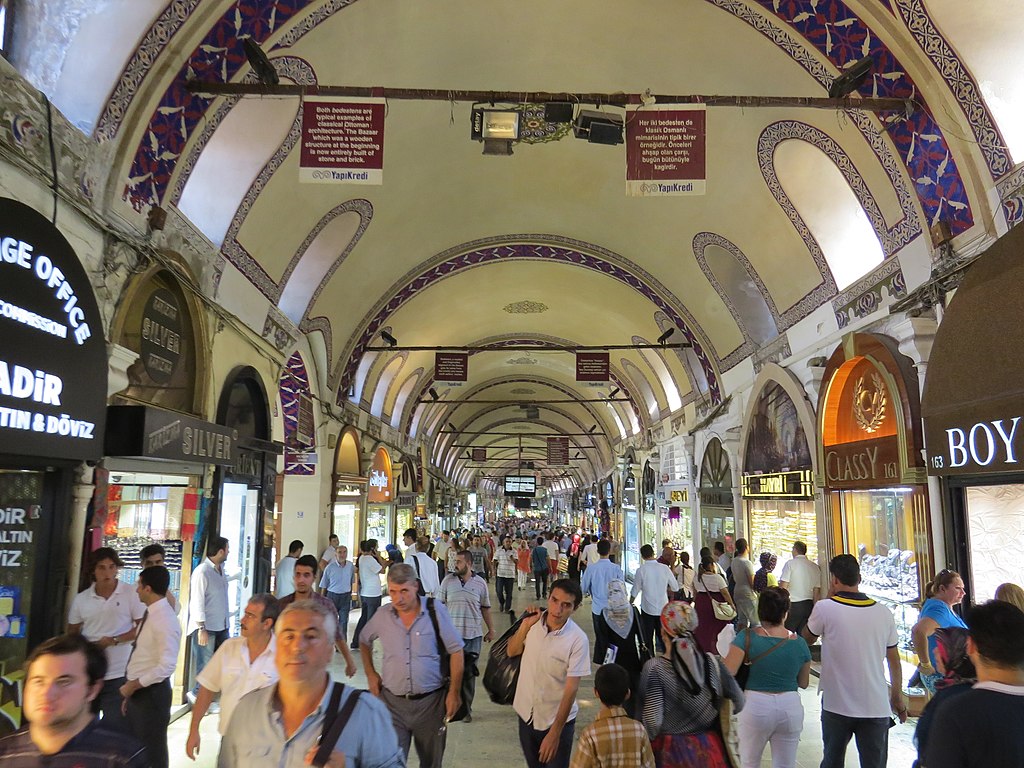 David Berkowitz from New York, NY, USA, CC BY 2.0, via Wikimedia Commons
David Berkowitz from New York, NY, USA, CC BY 2.0, via Wikimedia Commons
The Grand Bazaar is a covered market in Istanbul’s Fatih district and is one of the largest and oldest in the world. The covered market is home to at least 4,000 shops with an area of about 30,700 square meters and 61 covered streets.
The Grand Bazaar was built shortly after Constantinople was conquered by Mehmed II, during the winter of 1455/1456.
Mehmed II’s aim in building the Grand Bazaar was to stimulate the economy in Istanbul.
The construction of this covered market went through several stages, and finally, the Grand Bazaar reached its final form in the early 17th century.
The vast power of the Ottoman Empire and the control of good communication between Asia and Europe made the Grand Bazaar the center of Mediterranean trade at the time.
According to some sources, the Grand Bazaar was an unrivaled market in terms of the sheer number of goods, variety, and quality of goods sold.
The Grand Bazaar can accommodate 250,000 to 400,000 visitors every day. In fact, it was named the world’s number 1 most visited tourist attraction in 2014 with 91,250,000 visitors annually.
Grand Bazaar is considered one of the first shopping malls in the world.
6. Dolmabahce Palace.
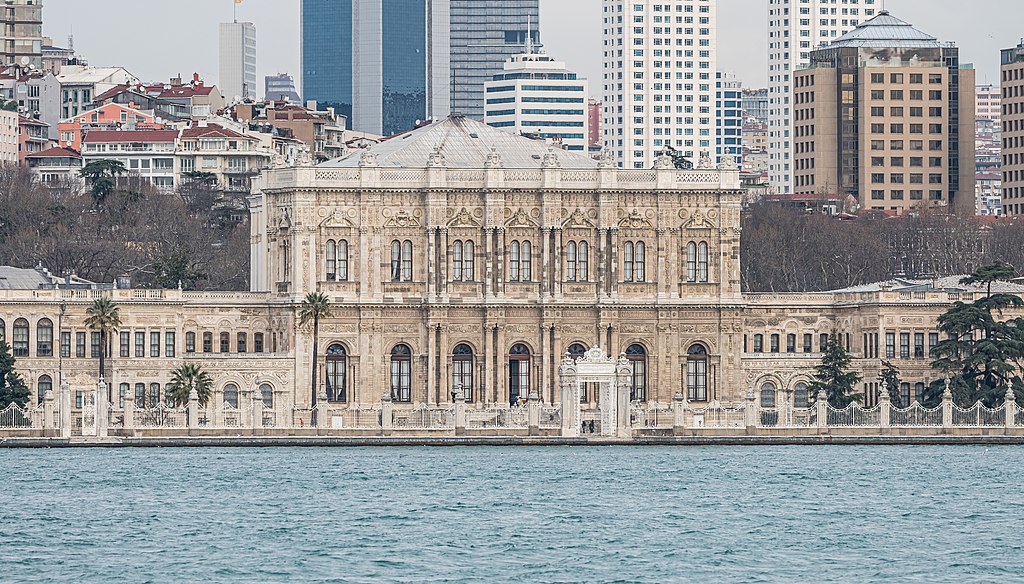 A.Savin (crop by Magnum5051), FAL, via Wikimedia Commons
A.Savin (crop by Magnum5051), FAL, via Wikimedia Commons
Dolmabahce Palace was the administrative center of the Ottoman Empire, having previously been located at Topkapi Palace, from 1856 to 1887 and 1909 to 1922.
Dolmabahce Palace was built between 1843 and 1856 on the orders of the 31st Ottoman Sultan, Abdulmejid I.
Abdulmejid I wanted a new palace because he considered Topkapi Palace to be less comfortable, less luxurious, and far from contemporary compared to other European monarchies.
The location Abdulmejid chose for the construction of Dolmabahce Palace was close to the former Besiktas Sahil Palace which had been demolished.
This location was once a bay on the Bosphorus that was used to anchor the Ottoman fleet. In the 18th century, the area was gradually reclaimed into an imperial garden.
This is where the name Dolmabahce comes from. Dolma means “filled” and Bahce means “garden”. Dolmabahce means “filled-in-garden”.
From 1856 to 1924, Dolmabahce Palace was home to 6 Ottoman Sultans. The last Sultan to live here was Abdulmejid Efendi.
On March 3, 1924, the law transferred the ownership of Dolmabahce Palace to the National Heritage of the new Republic of Turkey.
Turkey’s founder and first president, Mustafa Kemal Ataturk, used the palace as his presidential residence during the summer. He spent his last hours of medical treatment here and died on November 10, 1938.
7. Spice Bazaar.
 Savvas Alexandrou, CC BY-SA 4.0, via Wikimedia Commons
Savvas Alexandrou, CC BY-SA 4.0, via Wikimedia Commons
Spice Bazaar is a popular covered market in Istanbul after the Grand Bazaar. It is located in the Eminonu neighborhood in the Fatih district.
The name of this market was first “New Bazaar”.
In 1660, the market was built with financial resources from the Ottoman Egyptian eyalet, so the Spice Bazaar became known as the “Egyptian Bazaar”.
The construction of the Spice Bazaar coincided with the New Mosque from 1660 to 1665 on the orders of Sultana Turhan Hatice, the queen mother of Sultan Mehmed IV.
Spice Bazaar is still the center of the spice trade in Istanbul today. However, in recent years, several other types of shops have moved in and replaced the spice shops.
The Spice Bazaar was built in the same complex as the New Mosque. The income from the rental of the shops in the bazaar is used for the maintenance of the mosque.
Gallipoli.
Gallipoli Peninsula.
 Gucabdullah, CC BY-SA 4.0, via Wikimedia Commons
Gucabdullah, CC BY-SA 4.0, via Wikimedia Commons
Gallipoli Peninsula is considered the most touching place in Turkey today. This is where the World War I battlefields were located.
The Gallipoli Campaign was a military campaign in World War I that took place from February 17, 1915, to January 9, 1916, on the Gallipoli Peninsula.
The main objective of the Gallipoli campaign was to weaken the Ottoman power, which was then one of the strongest forces in the Central Powers.
The Entente powers, Britain, France, and Russia sought to control the Ottoman straits so that the Ottoman capital of Constantinople could be easily destroyed by Allied warships and separated from the Asian empire.
With the Turks defeated, the Suez Canal would be safe so that the Allied supply route through the Black Sea to warm water ports in Russia could be open all year round.
Canakkale.
Troy (Truva).

Troy (Truva) was an ancient city located near Canakkale, in Hisarlik in present-day Turkey.
In a Greek myth, Troy is described as the setting of the Trojan War.
Troy was believed to be a powerful kingdom in a mystical era where gods could interact directly with humans, and monsters roamed the earth.
Troy is said to have ruled the Troad until it was completely destroyed by the Greeks during the Trojan War.
The story of Troy’s destruction features prominently in the Iliad and the Odyssey and is referenced in many other poems and plays. The story became a cornerstone of Greek mythology and literature.
The story of Troy influenced many lives in Greece. Many families in Greece claim descent from those who fought at Troy.
The story goes on, until finally in the Archaic era a new city was built where the location is believed to have been where the legendary Troy stood.
But as late as the 19th century, scholars still thought that the Trojan War was a legendary story.
This changed in 1871 when excavations began on the site of the classical-era city where ruins of the previous settlement were found, resembling literary depictions of Troy.
Some scholars then assumed that there was a kernel of truth that corroborated the legend of Troy.
Excavations continue and add to the modern understanding of the site of Troy.
However, there is no clear connection between the myth and the reality, and no definitive proof that the Greeks ever attacked the city of Troy.
Bergama.
Pergamon (Pergamum).
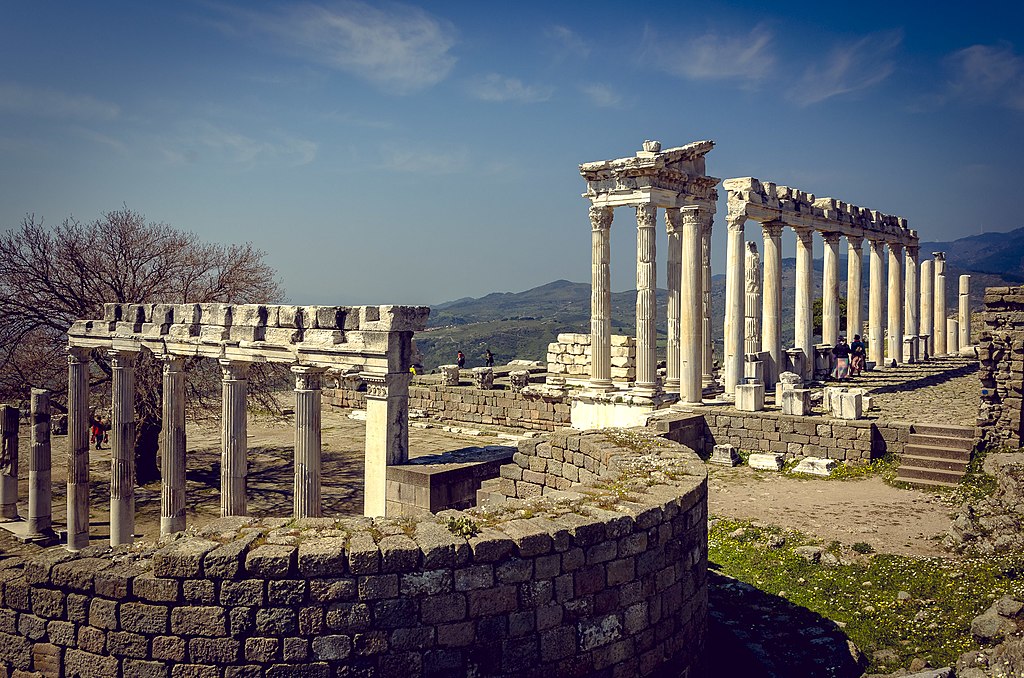 Murat Beşbudak, CC BY-SA 4.0, via Wikimedia Commons
Murat Beşbudak, CC BY-SA 4.0, via Wikimedia Commons
Pergamon was an ancient Greek city known for its wealth and power.
Pergamon is currently located northwest of the modern city of Bergama in the Turkish province of Izmir.
As quoted in the New Testament Book of Revelation, Pergamon is the northernmost of the seven churches in Asia.
During the Hellenistic period of 281-133 BC, Pergamon was the capital of the Kingdom of Pergamon under the Attalid Dynasty. During this time, Pergamon became a major cultural center of the Greek world.
The masterpiece Pergamon Altar and many other monuments can still be seen today.
Pergamon was included in the UNESCO World Heritage list in 2014.
Kusadasi.
1. Ancient City of Ephesus.
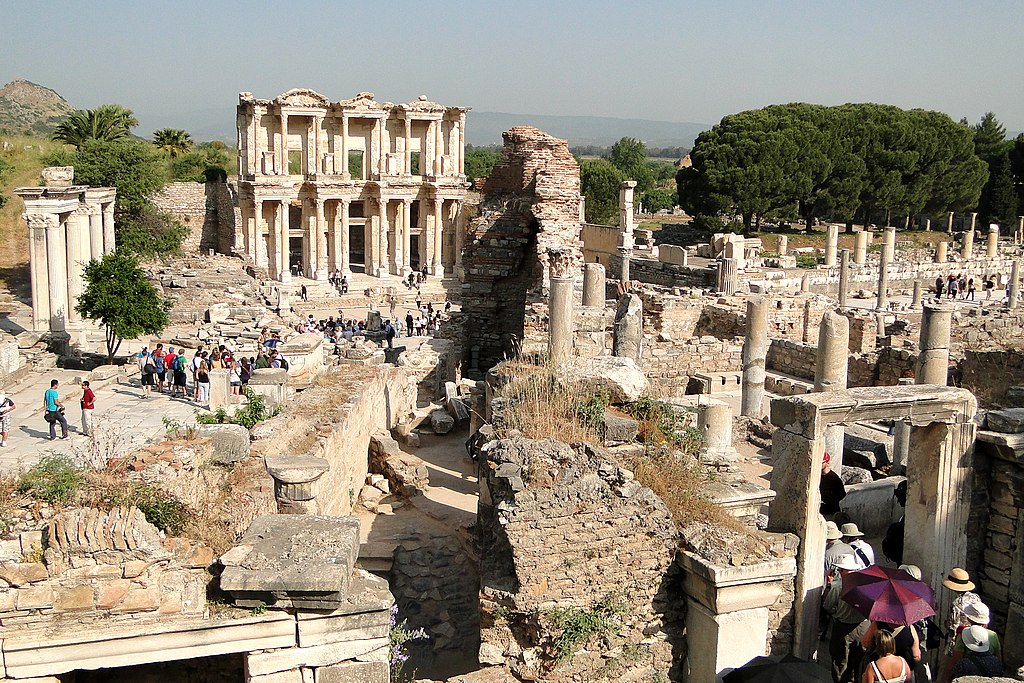 Adam Jones from Kelowna, BC, Canada, CC BY-SA 2.0, via Wikimedia Commons
Adam Jones from Kelowna, BC, Canada, CC BY-SA 2.0, via Wikimedia Commons
The ancient city of Ephesus was once the oldest Greek settlement on the Laur Aega and one of the largest and most important cities in the ancient Mediterranean world.
Ephesus today is on the west coast of Asia Minor, the Central Aegean region, close to modern-day Selcuk in Turkey’s Izmir province.
The remains unearthed at Ephesus show that the city has had a long journey through the centuries, from classical Greece to the Roman Empire.
Ephesus also played a role in the spread of Christianity.
Ephesus was once the center of Roman rule in Asia.
Ephesus’ strategic location, at the end of the Royal Road (the main Eastern Roman highway), made the city an important part of trade at that time as the western end of the East-West trade.
Ephesus had an important Mediterranean port that served as a gateway for exporting goods to Greece, Italy, and other Western Roman territories.
Ephesus continued to prosper, with Emperor Augustus’ reforms boosting the city’s economy and beginning a period of peace until the third century AD.
It is known that the major construction of Ephesus began during the reign of Emperor Augustus and his successor Tiberius. This period of prosperity and stability lasted until 180 AD.
Ephesus developed around the ancient temple of the Earth Goddess Artemis (Roman Diana) making it also an important part of the expansion of Christianity in the early Christian era.
2. The Temple of Artemis.
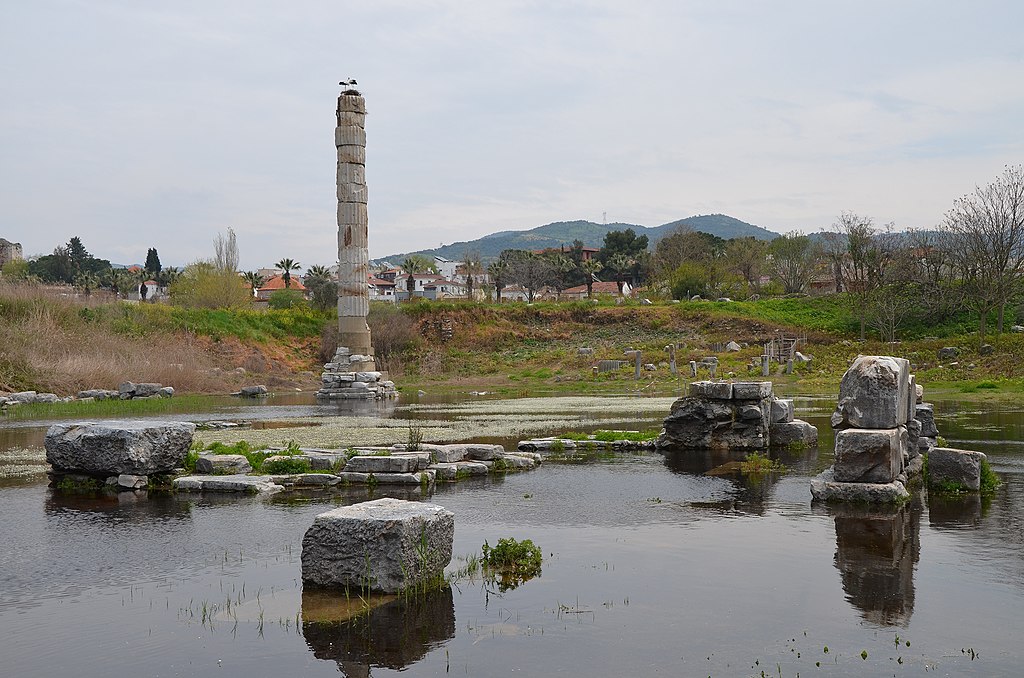 Carole Raddato, CC BY-SA 2.0, via Wikimedia Commons
Carole Raddato, CC BY-SA 2.0, via Wikimedia Commons
The Temple of Artemis is a Greek temple still located in Ephesus, dedicated to an ancient form of the goddess Artemis.
Artemis was identified with Diana, the Roman goddess. Hence the Temple of Artemis is also known as the Temple of Diana.
The Temple of Artemis is now located near the modern city of Selcuk in Turkey.
But today we can only see the remaining foundations and the last temple fragments at the site. The Temple of Artemis was destroyed in 401 AD.
In a Bronze Age temenos, the earliest version of the temple, it is mentioned that the Temple of Artemis was destroyed by a flood.
The reconstruction of the Temple of Artemis was done in a more magnificent form around 550 BC. The reconstruction project was funded by Croesus of Lydia under Chersiphron, the Cretan architect, and his son Metagenes. The reconstruction took about 10 years.
However, the version of the temple after this reconstruction was destroyed by an arsonist in 356 BC.
The final, largest form of the temple was later self-funded by Ephesus. This is mentioned in Antipater of Sidon’s Seven Wonders of the World.
3. Meryemana (The Virgin Mary’s House).
 Erik Cleves Kristensen, CC BY 2.0, via Wikimedia Commons
Erik Cleves Kristensen, CC BY 2.0, via Wikimedia Commons
The House of the Virgin Mary, in Turkish, is also called Meryemana Evi, “House of Our Lady”.
The House of the Virgin Mary is also located not far from Ephesus, precisely on Mount Koressos, 7 km from Selcuk in Turkey.
The House of the Virgin Mary was discovered in the 19th century based on visions reported by a Roman Catholic nun and visionary, Blessed Anne Catherine Emmerich between 1774-1824.
Blessed Anne Catherine Emmerich was beatified by Pope John Paul II on October 3, 2014.
No Catholic Church has ever declared for or against the authenticity of the house. But ever since the House of the Virgin Mary was discovered, there has been a steady flow of pilgrims to the house.
Catholic pilgrims who come to the House of the Virgin Mary believe that Mary, the mother of Jesus, was brought to this stone house by St. John and lived there until the end of her life.
Pamukkale.
1. Cotton Castle.
 Ad Meskens/Eva Meskens, CC BY-SA 3.0, via Wikimedia Commons
Ad Meskens/Eva Meskens, CC BY-SA 3.0, via Wikimedia Commons
Pamukkale, in Turkish means “Cotton Castle”.
Pamukkale is a natural site in southwestern Turkey, in Denizli province. The site is located in Turkey’s Inner Aegean region, in the valley of the Menderes River. The area has a temperate climate throughout the year.
Pamukkale is famous for the carbonate minerals left by the flow of hot springs here.
The calcite-rich spring water left behind over thousands of years builds up over time, forming natural white pools of sparkling snow-white pure cotton.
Pamukkale has attracted countless visitors from classical antiquity to the present day.
2. The Ancient City of Hierapolis.
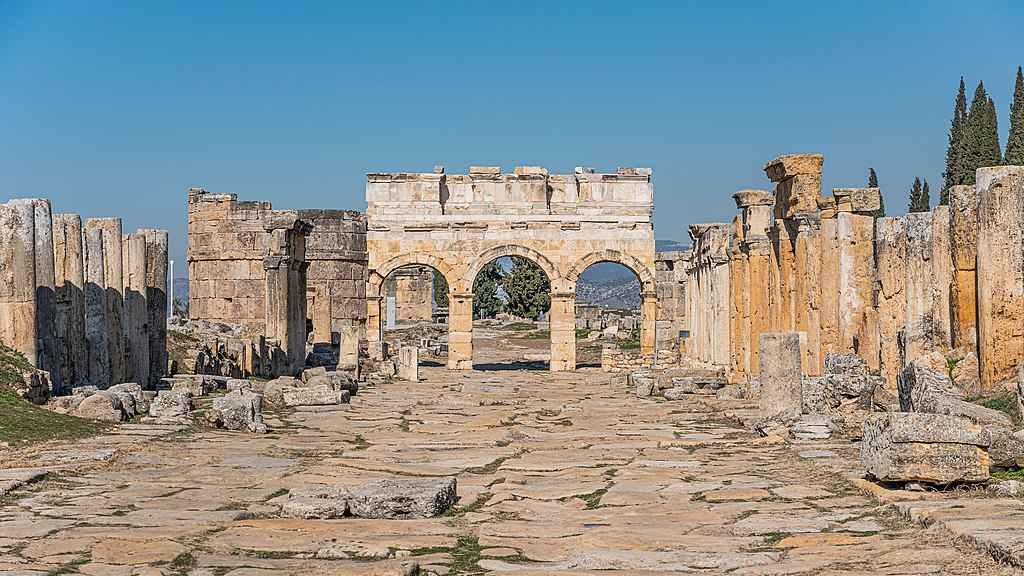 A.Savin, FAL, via Wikimedia Commons
A.Savin, FAL, via Wikimedia Commons
The ancient city of Hierapolis is an ancient city built on travertine formations, centered on hot springs in southwestern Anatolia. Its remains can now be found near modern-day Pamukkale in Turkey.
The ancient city of Hierapolis was built by the Phrygians to be dedicated to the mother goddess Cybele. The city is thought to have been built in the first half of the 7th century BC.
The temple used by the indigenous people living in the Lykos valley was planned to be the center of Hierapolis.
Greek colonizers came to Hierapolis and built the city following the pre-existing settlement pattern. The ancient cult of Cybele was then gradually assimilated into Greek religion.
The temple that was originally dedicated to the mother goddess Cybele, after being assimilated into Greek culture came to be associated with Hades (Pluton) and Persephone. And the temple was given the name Plutonium.
The first purpose of Hierapolis in the early 2nd century BC was as a thermal spa in the Seleucid Empire.
Hierapolis was home to at least 50,000 Jews in 62 BC.
Located in the center of a hot spring, Hierapolis was once a healing center where doctors of the time used the hot spring as a treatment medium for their patients.
The ancient city of Hierapolis was included in the UNESCO World Heritage List in 1988.
Cappadocia.
Cappadocia, apart from Istanbul, is a must-visit destination when we are on vacation in Turkey.
The atmosphere in Cappadocia is unique, which you might only find one of its kind in the world.
Tour Cappadocia is very worthy for you to do while in Turkey.
Do you want to tour Cappadocia from Istanbul? Some of our recommended packages below might be suitable for you:

2 Days PRIVATE Tour Cappadocia From Istanbul By Plane: A Convenient Quick Turkey Tour Package Recommendation
It is not easy now to find a short but comfortable Turkey tour package. Not only sightseeing for instagrammable photos, but also getting a quality tour experience. A 2 days private tour visiting Cappadocia from Istanbul with return flights is the perfect answer. Not everyone has a lot of time when they come to Turkey….

Cappadocia Hot Air Balloon Tour From Istanbul: A Perfect Way To Have A Superb Experience In A Short Time
People look for a Cappadocia hot air balloon tour package from Istanbul because they crave simplicity. They don’t want to deal with many parties associated with ticketing arrangements, hotels, transportation, etc. They want to be served from departure from Istanbul, tour in Cappadocia, hot air balloon ride and return back to Istanbul comfortably. Istanbul and…
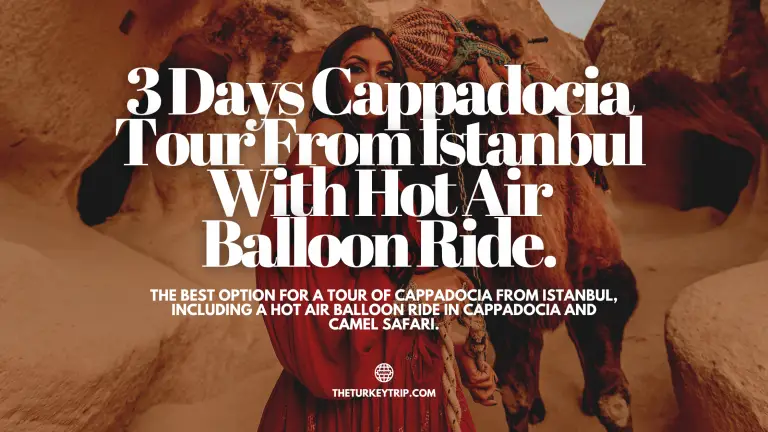
2 Nights 3 Days Cappadocia Tour Package From Istanbul Including Hot Air Balloon Ride & Camel Safari
In general, people who come to Turkey, especially to Istanbul, will then seek a tour package to Cappadocia. One of the most sought-after is the 2 nights 3 days Cappadocia tour package from Istanbul. In a relatively short time, we can tour popular tourist attractions as well as have the opportunity to ride a hot…

Recommended 2 Days Cappadocia Tour From Istanbul By Plane With An Optional Hot Air Balloon Ride
A 2 days Cappadocia tour from Istanbul by plane is one of the most hunted by many tourists who come to Turkey. The tour time is relatively short, but you still have the opportunity to visit many favorite tourist attractions in Cappadocia. And optionally you can still ride a hot air balloon. If we talk…
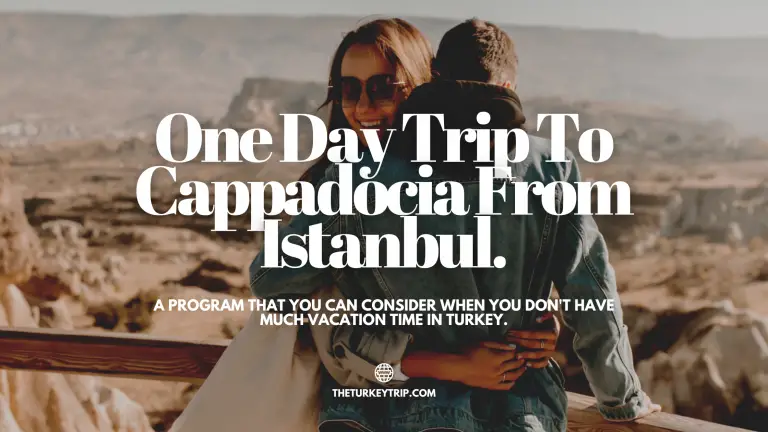
A Thing You Can Do In Istanbul: One Day Trip To Cappadocia From Istanbul With Round-Trip Flights
A day trip to Cappadocia from Istanbul is a quick getaway solution for those with limited time in Turkey. You will experience the morning in Istanbul, fly to Cappadocia and tour there, and return to Istanbul in the afternoon or evening. As we all know, when we talk about tourism in Turkey, the first thing…

5 Best Recommended Istanbul To Cappadocia Tour Packages
In fact, Istanbul and Cappadocia are two of the most popular areas for sightseeing in Turkey. The good news is, there are many choices of tour packages from Istanbul to Cappadocia. Plus, we can also visit popular tourist destinations which are located between the two such as Bursa, Kusadasi, and Pamukkale. If we talk about…
1. Devrent Valley.
 Ekke from Durham, United Kingdom, CC BY 2.0, via Wikimedia Commons
Ekke from Durham, United Kingdom, CC BY 2.0, via Wikimedia Commons
Devrent Valley is also known as Imaginary Valley and Pink Valley because of its color.
Unlike other valleys in Cappadocia, Devrent Valley has no cave churches and no Roman castles or tombs.
What makes Devrent Valley popular among other valleys is the many rock formations here that resemble animals. Some even think that Devrent Valley is a naturally created sculpture zoo.
It does take some imagination when looking at the rock formations here. But of the many formations, the most common and easy to see are the shapes of camels, dolphins, seals, and snakes.
For those who have a wild imagination, maybe you will be able to find other shapes such as dragons and clouds. Some can even see stone pillars shaped like the Virgin Mary holding Jesus Christ.
2. Pasabag Valley.
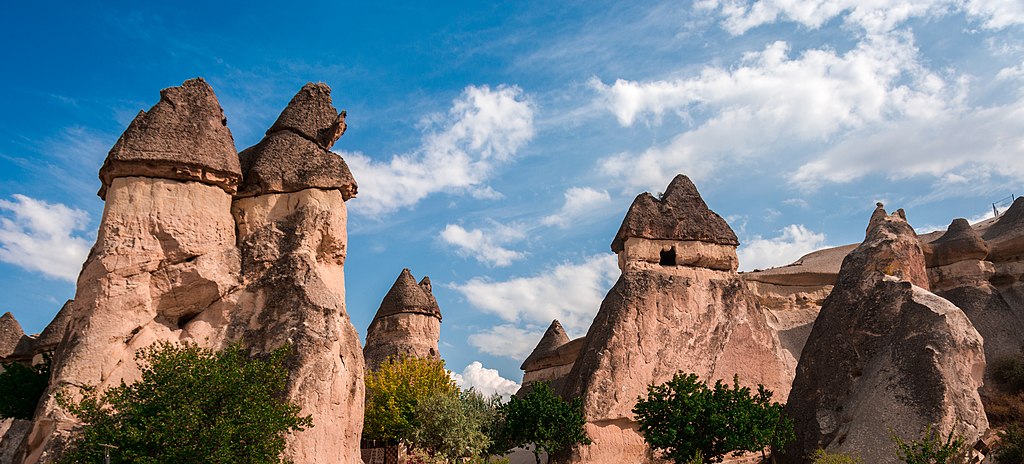
Pasabag Valley has another popular nickname, Monks Valley.
But actually, the Turkish name of Pasabag Valley translates as “Pasha’s vineyard”. Pasha was the highest honorary title of the Ottoman Empire after the sultan. Not without reason, the fact that Pasabag Valley is located in the middle of a vineyard.
The name Monks Valley was given by westerners, as the valley was once used as a hermitage of the monk Simeon who once inhabited this area.
St. Simeon was actually a monk who lived alone in Aleppo, Syria, in the 5th century. But later rumors emerged that he had the power to perform magical treatments. This story led to him being visited by many unwanted visitors.
Eventually, St Simeon decided to resume his ascetic life and decided to live in a 2-meter-high fairy chimney in Pasabag Valley before moving on to a 15-meter fairy chimney. St. Simeon would only come down to find food and water.
St. Simeon’s lifestyle inspired many Christian monks and hermits from Cappadocia, and they did exactly the same as St. Simeon did. This is how the name Monks Valley came to be.
The shape of the rock formations in Pasabag Valley is unique, the tall rock structure topped with an inverted mushroom shape.
3. Avanos.

Avanos is a town in Nevsehir province in Turkey’s Central Anatolian Cappadocia.
Avanos was formerly known as Venessa.
A well-known industry in Avanos is pottery production. This industry has been going on for a very long time, from the Hittite period to the present day.
The location of Avanos is on the river, making the basic material for pottery production easily available from clay from the Kizilirmak red mud.
Venessa, ancient Avanos, was one of the third most important cities in the Kingdom of Cappadocia (between 332 BC and 14 AD). It was the site of an important Zeus temple, but nothing remains today.
The only remnants of Avanos’ 19th and early 20th-century history that can be seen today are the impressive stone houses. These stone houses were built by the Greek and Armenian populations and can be found in the older town north of the river.
Avanos is different now. There is a lot of modern housing on the south side of the river and it is also developed for tourist purposes.
Workshops or the pottery-making industry can still be found today in Avanos Cappadocia.
4. Goreme Open-Air Museum.
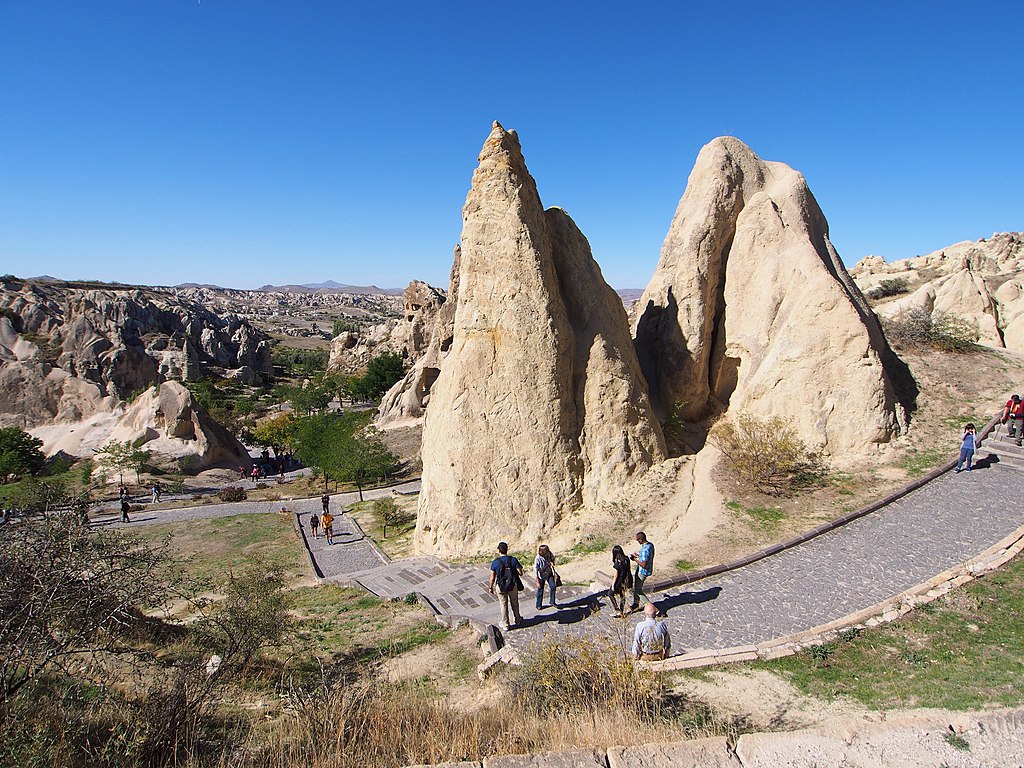 rheins, CC BY 3.0, via Wikimedia Commons
rheins, CC BY 3.0, via Wikimedia Commons
Goreme Open-Air Museum is a church complex, where each church has a monastery with a dining hall connected to each church. There are eleven dining halls in the museum.
Most of the churches in the Goreme Open-Air Museum date back to the 10th, 11th, and 12th centuries.
Goreme Open-Air Museum contains the finest cut-stone churches, the interiors of which are dominated by exquisite frescoes. The colors of the paintings are very fresh, still like the originals.
Goreme Open-Air Museum is a testament to how beautifully stone-carved architecture and fresco techniques can blend.
In the Goreme Open-Air Museum, the most famous church museum is the Dark Church. It is located at the highest point of the trail.
The name Dark Church comes from the fact that the church only has a few windows. This condition is favorable for the church so that the frescoes inside are still well preserved.
The Dark Church was restored at great expense. Those who want to enter this church are charged an additional entrance fee, to limit the number of visitors so that the frescoes inside are well maintained.
Goreme Open-Air Museum was included in the UNESCO World Heritage list in 1984.
5. Uchisar Castle.
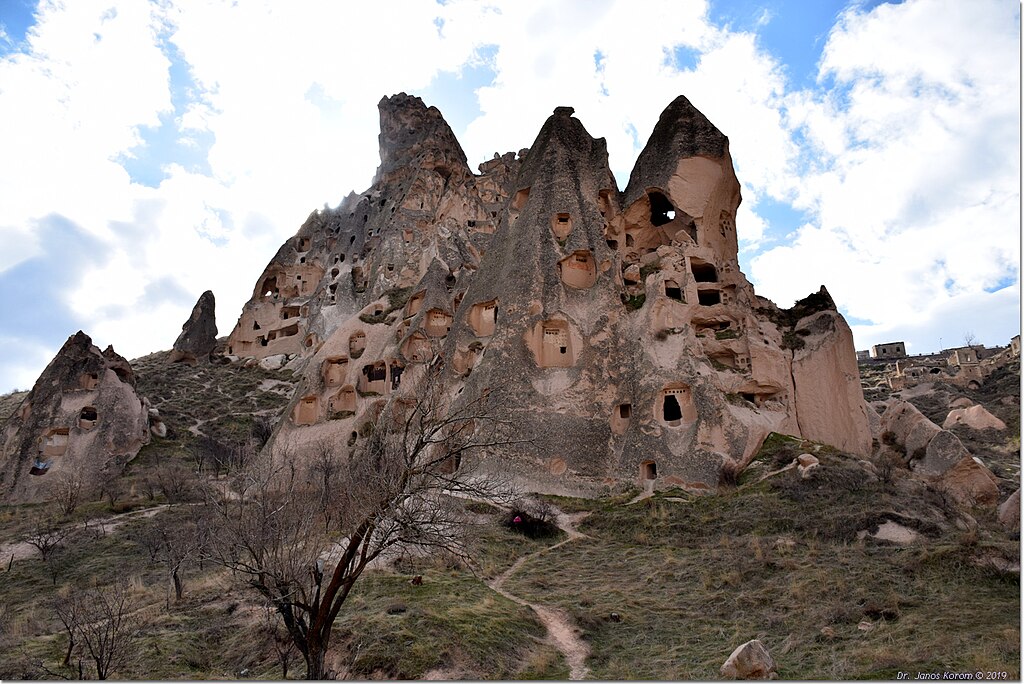 János Korom Dr. >17 Million views from Wien, Austria, CC BY-SA 2.0, via Wikimedia Commons
János Korom Dr. >17 Million views from Wien, Austria, CC BY-SA 2.0, via Wikimedia Commons
Uchisar Castle is thought to have once been a major defense fortress of Cappadocia.
The area was settled by people from the 7th to 8th century. Those who came here were fleeing Islamic rule in the underground city.
Uchisar Castle was first mentioned in a chronicle by Abdul Aziz ibn Ardasir in the 14th century. At that time Turkey was still under Ottoman control.
However, since it is also known that the Uchisar area was inhabited in the 7th to 8th centuries, it is possible that Uchisar Castle was built earlier than the 14th century.
The rock in Cappadocia is volcanic tuff which is very soft, making it very easy to mold.
Uchisar Castle was made by hollowing out the rock into adjoining rooms.
In the Byzantine era, these rooms were used as homes for soldiers.
The caves in Uchisar Castle were made into multi-level rooms and underground passages. Many of them have deteriorated due to aging and weathering. The ones that are still in good condition today can still be found on the north side of the castle. This area that is still in good condition is possible for tourists to visit.
In its heyday, Uchisar Castle could accommodate around 1,000 people living inside.
6. Cavusin Village.
 Ji-Elle, CC BY-SA 3.0, via Wikimedia Commons
Ji-Elle, CC BY-SA 3.0, via Wikimedia Commons
Cavusin is the oldest settlement in Cappadocia, located along the road between Goreme and Avanos.
Cavusin village is home to various sites such as the ruins of Christian monks and several churches such as the church of Saint Yahya and Cavusin Church, which are now popular tourist attractions in Cappadocia.
Cavusin Church is unique in that it is decorated with moments that tell important stories of the time.
Another church, St. John the Baptist Church, which dates back to the 5th century, is the oldest and worth a visit in Cavusin Village.
The Christians who came to Cavusin at that time were there to escape the pressure of the Romans, so they could practice their religion comfortably by creating a living space in the cavity they dug into the fairy chimney.
Cavusin is also famous for its pottery products, which were started by the Hittites in the 2nd millennium BC. Today, you can still find pottery workshops here while taking a leisurely walk to enjoy the atmosphere of Cavusin Village.
Cavusin is now also a great hiking trail. Trekking here is highly recommended for those who love sports and nature, in addition to ATV rides and horse safaris.
7. Kaymakli Underground City.
 MusikAnimal, CC BY-SA 4.0, via Wikimedia Commons
MusikAnimal, CC BY-SA 4.0, via Wikimedia Commons
Kaymakli Underground City, whose ancient name is Enegup, is considered one of the largest in Cappadocia apart from Derinkuyu.
Kaymakli Underground City was built in soft volcanic rock in the 8th to 7th century BC by the Phrygians.
Four centuries of war between Arabs and Byzantines saw the Kaymakli Underground City continuously expanded and deepened.
In the Middle Byzantine period, between the 5th and 10th centuries, several artifacts were found in Kaymakli Underground City.
Kaymakli Underground City continued to be used by Christians until the 14th century as a refuge from Mongol raids to the East.
Kaymakli Underground City continued to fulfill its role as a refuge from outside threats until the 20th century. Even when the region changed rulers.
People used large round stones as doors, in case of external attack.
Inside the Kaymakli Underground City, there are nearly a hundred tunnels that descend into 8 levels, estimated to go 20 meters underground. Only 4 levels are open to the public today.
Not only houses, but Kaymakli Underground City also served as a cellar, bakery, chapel, and stables.
Kaymakli Underground City is connected to Derinkuyu by miles of tunnels.
Conclusion.
10 days is enough for a vacation in Turkey.
Based on our experience, the best time to explore Turkey is 7 to 10 days. Of course, what can be seen in Turkey in 10 days will be more when compared to 7 days.
Even with 7 days, you can already have a vacation and visit many places in Turkey.
>> For your other references: Recommended 7-day tours in Turkey.
It would be even better to be able to use domestic flights during a multi-day tour in Turkey because we can minimize the time wasted.
There are indeed many choices of destinations when we plan to vacation in Turkey for 10 days. It depends on your destination and the time when you will vacation.
For example, if you are going on vacation in Turkey during winter, you can include a visit to Bursa to ski on Mount Uludag. Or if you are planning a vacation in Turkey during the summer, you can head to coastal areas to enjoy some of Turkey’s beautiful beaches.
The destinations mentioned here are more about historical and cultural places in Turkey, regardless of the season.
As we know, Turkey is one of the most popular tourist destinations in the world because of its rich history and culture, apart from its beautiful nature. So we recommend that when you are traveling in Turkey, especially if it is your first time in Turkey, visit the historical and cultural places here.
A 10-day tour in Turkey visiting historical, cultural, and natural beauty places will be perfect for your family trip.
Do you want a 10-day tour in Turkey visiting the places above? Click the button below to see the tour package:


